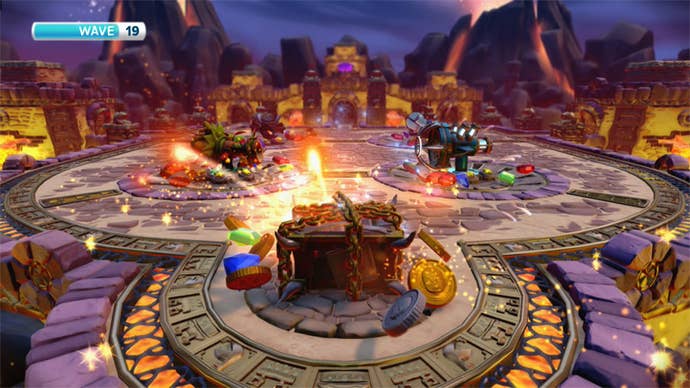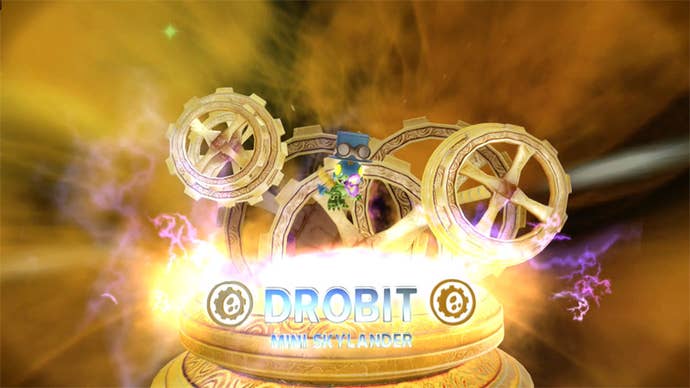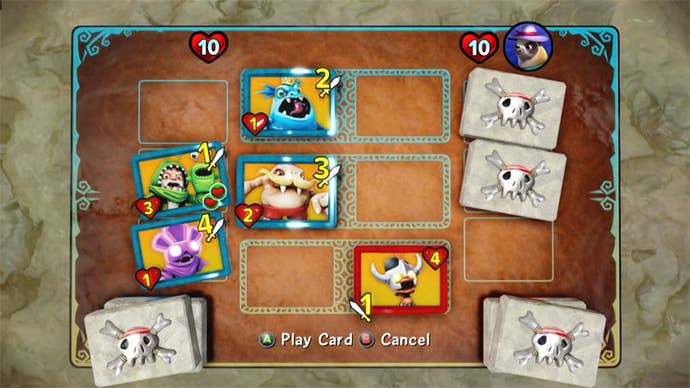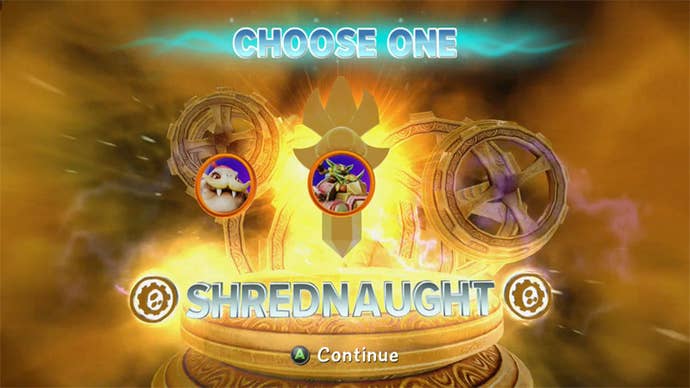Skylanders: Trap Team Xbox One Review: Evil is the Job
The latest entry in the subversively good megahit for kids excels on the strength of its surprisingly lovable villains.
This article first appeared on USgamer, a partner publication of VG247. Some content, such as this article, has been migrated to VG247 for posterity after USgamer's closure - but it has not been edited or further vetted by the VG247 team.
Video games have a tendency to inspire a certain amount of chauvinism among core fans. I don't mean chauvinism in the sense of sexism (though there's plenty of that, too).
No, I mean it in the more general sense of the word: A patronizing or aloof air of superiority. It's built into the language of fandom; consider terms like "hardcore" games versus "casual," where casual means "designed to appeal to women, children, and older players." But really, that's true for every form of entertainment. Video games has its people who sneer at "casuals" or froth about the technical specs of the latest AAA game. Pop literature has readers who refuse to watch a film adaptation of book. Music has listeners who will only buy albums that popular bands recorded before their first chart-topping hit. And there are the film buffs who... well, you get the idea.
And that's fine. Creative mediums need obsessive, demanding fans to drive innovation and encourage both publishers and creators to continue pushing the boundaries. But those mediums need fresh blood, too, to continue growing the ranks. And in order for that to happen, those "casual" titles are just as essential as the core games. Just look to the classic shoot-'em-up to see what happens when a format forgets to offer some accessibility: It folds in on itself and eventually collapses.

So thank goodness for Skylanders, which unapologetically caters to young and inexperienced players without being condescending about it. The latest entry in the franchise, Trap Team, offers an aggressively kid-friendly experience. It lacks the bite that dedicated game enthusiasts demand in their escapism, and yet despite the game's low difficulty threshold and tendency to walk you through puzzles and challenges even in the latter portions of the adventure (because, let's face it, the seven-year-old boys the game targets are terrible at paying attention to instructions), it nevertheless adopts a remarkable number of "hardcore" game mechanics.
In a sense, Trap Team works as training wheels of sorts: My First AAA Game. It has multi-classing, with different tiers of characters and different specialties. It incorporates a rudimentary experience system, an economy, and even branching character upgrade paths. It makes use of classic RPG concepts like elemental affinities, offers two forms of character tag-teaming, and incorporates little slices of pretty much every genre you could imagine in easy-to-digest snippets. Rail shooter? That's in there. Tower defense? There's an entire sub game dedicated to it. Angry Birds clone? You bet!
With Trap Team, even more than with previous Skylanders titles, developer Toys for Bob has broken hardcore game mechanics into their basic components and rebuilt them in a simple, approachable manner. Like a mother bird partially digesting a worm for her young, Skylanders basically indoctrinates novice players into the gaming mainstream by feeding them a paste of grown-up game concepts in a colorful, character-driven style.
And that's really the important thing here: Despite being targeted directly at elementary school age boys, Trap Team doesn't scrimp on quality. It looks fantastic, the controls are responsive, the music is buoyant and lively, and it offers a ridiculous amount of diversity. The number of Skylanders characters you can potentially use in the game approaches second-gen Pokémon levels, and each character has its own unique skill set, evolutionary path, hidden ultimate power, and appearance. Any Skylander you can use, you can customize; even if you bring in a fully leveled-up hero from a previous game, you can still tweak it a bit by giving it a silly new hat or other decoration.
That was the point at which I decided I liked Trap Team, actually. The point where I took a tiny robot dragon that shoots lasers out of its eyes and gave it a top hat and a flower to hold in its teeth.

It's easy to look at Trap Team and see only the monetary element of the game — and, yes, spending money is designed from the ground up to be a big part of the game. Like all Skylanders games, Trap Team revolves around microchipped character figurines that interact with a mandatory USB-powered "portal"; place a figurine on the portal and you take control of that character in the game. While you can technically complete the core game with only the two characters that come bundled with this entry's game and portal, much of the experience remains inaccessible unless you buy a slew of add-on items.
The characters who tie into this year's "trapping" gimmick, the Trap Masters, are the only ones who can open certain gates, and that ability ties in with their respective elements. In order to open every gate and unlock every hidden area of the game, you'll ultimately need to buy nine different Trap Masters at $15 apiece. On top of that, you'll also need to buy interactive traps for capturing villains, which will set you back another $45. Going all-in to totally conquer Trap Team represents a pretty significant monetary investment. Sorry, moms of the world.
As exploitative as all of this may sound, these Trap Master gates are generally pretty superfluous; they usually just unlock cosmetic upgrades or small shop discounts, stuff you can live without. Unless you're after a Platinum trophy or just hate the idea of not earning 100% completion on a game, all you really need to get the most out of the game is a full set of traps and maybe the figures for a handful of heroes you particularly like — an added expense, yes, but vastly cheaper than getting a full set of figurines.
In a sense, the traps allow you to incorporate a large number of additional characters into your game for a low cost. Traps allow you to capture and play as the game's bosses, and while you can only hold one boss per trap at a time — which trap you need for a given boss is determined by its elemental affiliation — you can swap out between any captured bosses back at the hub world. While the traps don't make for toys as fun as the character figurines, their generic nature means they give you access to as many as six possible playable characters.

In-game, your captive bosses can tag in for a short while at the press of a button, taking the place of your main hero until their timer/life bar runs down to zero. While not in action, your current captive sits in a special plug in the portal and makes snarky comments from the device's built-in speaker. In a sense, the bosses become the real characters in the game; heroic Skylanders make battle grunts and recite their personal catch phrase when you swap them in, but the bosses spout off constantly with a wide array of amusing situational comments. It's a small detail that really lends strength to the interactive toy element of Skylanders, to the point that you might find yourself teaming up with a specific villain not because of its combat efficacy but because you enjoy its running real-world commentary.
That interactivity is a big part of Skylanders' appeal. It's easy to see why other kid-oriented brands — namely Disney and Nintendo — have been eager to copy the Skylanders concept. It's a brilliant extension of video game play into real-world play, creating a tactile experience that offers quite an antidote to the all-digital forward march of the medium. Skylanders is the opposite of digital-only; it revolves entirely around the interaction of the real and the virtual, with cleverly complementary toy and console design heightening the sensation that you're actually sending trapped bad guys into the device sitting next to your couch.
The a la carte approach of Skylanders works to its credit, I think. It's a perfectly fun (if somewhat naggingly incomplete) game at its base level, and the more toys you add the more unlocks. At the moment, it's actually impossible to fully complete the game, as several characters and two entire elements aren't yet available for purchase; those pieces will become available down the road, as additional waves of Trap Team figures hit the market. Honestly, Activision could start a figure subscription service and call it a "Skylanders season pass" and the metaphor would totally work. Now, as to whether or not it's cool the series is indoctrinating kids not only into the mechanics of core games but the extended business model as well... that's a debate worth having.

But then again, I look at free-to-play/pay-to-unlock games on mobile, and compared to some of that dreck, Skylanders at least has quality working in its favor. The underlying game really is solid — not to mention surprisingly rich in content. The core adventure runs about 15 hours, but there's a wealth of other things to do. And at least the add-ons you buy net you some nifty interactive toys.
While Skylanders regulars may be growing weary of each sequel's new gimmick and the fact that Activision insists on selling you a new portal every year, Trap Team more than justifies its new mechanic. Teaming up with bosses — including, and I don't think this is a spoiler considering the "Kaos element" trap you can buy — main villain Kaos lends the game a huge amount of personality. Best of all, it further enhances the a la carte approach of the series. Skylanders can be as deep and time consuming as you like; you can sink a ton of money into it or none at all. You can be insanely aggressive about upgrading characters, choosing to min-max one hero or constantly revolving through a team of them.
Trap Team offers a fantastic starting point for the future video game fanatics of the world. Frankly, I'm jealous. I wish we'd had interactive toys half as cool as this when I was in the Skylanders demographic. But I can appreciate the quality invested in this adventure's design, just as I can enjoy the game's characters vicariously through the enthusiasm of my young nephews and cousins and kids of friends, whose eyes bulge wide at the sight of new characters and the new portal gimmick.
VisualsA vibrant cartoon of a game, especially on current-gen consoles. The in-game realization of the collectible figurines, as usual, is fantastic.
SoundThe sound mix can be a little lacking, but the cartoonish voice acting is top notch and the rollicking music — including a different theme for each captive boss! — is top stuff.
InterfaceSimple and to the point, all things considered. Seasoned gamers will find the constant hints and prompts annoying, but this isn't really meant for seasoned players.
Lasting AppealWith a meaty core game, a ton of side content, and timed unlocks, Trap Team is meant to devour a fan's time for months. But addiction can be expensive....
ConclusionWhile not without its questionable qualities — expect to pay $120 to get something approaching an optimal play experience — Skylanders: Trap Team continues the series' tradition of catering to kids by treating them with respect. And the new trapping gimmick more than justifies itself through the flexibility it offers... not to mention the amusing and diverse role it gives the game's villains.
